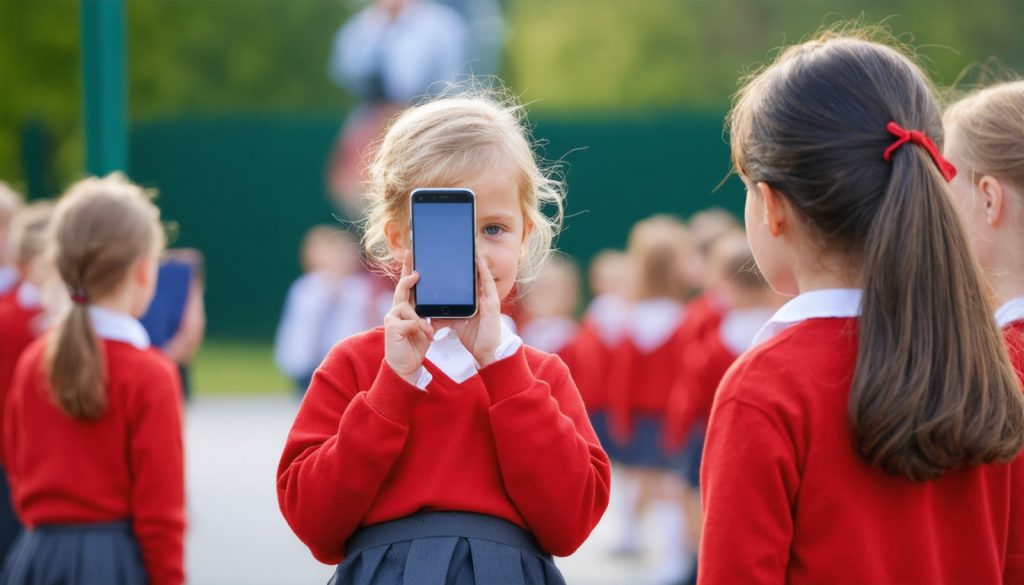
- Sophie Winkleman advocates for a ban on smartphones in schools, highlighting their profound impact on children’s lives.
- Smartphones contribute to physical issues such as weakened eyesight and spinal problems, and emotional issues resembling ADHD signs and digital isolation.
- A survey in England shows a growing trend to limit phone use in schools, yet some view these measures as insufficient.
- Independent MP Rosie Duffield emphasizes the need for more decisive action, criticizing the government’s reluctance to impose a full ban.
- The debate centers on balancing technological advancement with the protection of children’s wellbeing, urging policymakers and stakeholders to prioritize safety.
The glow of smartphones has long enchanted both children and adults alike, yet their deep-seated influence is sparking an urgent public discourse on their rightful place, especially in the realm of education. The notable Sophie Winkleman, known for her portrayal of Big Suze in the hit series “Peep Show” and titled as Lady Frederick Windsor, has stepped into this digital maelstrom, fervently advocating for a ban on smartphones in schools. Her stance isn’t just a whisper in the dark; it echoes with the authority of a royal declaration, calling for a reckoning with these ubiquitous devices.
Winkleman paints a vivid picture of children entrapped by the alluring glow of smartphone screens. They’re not merely conduits for messages and cat videos; in her view, they’ve become architects of a new-age child rearing that confines kids to an “unputdownable” cycle of consumption. This isn’t passive entertainment, she argues. It’s a systematic isolation, a descent into a virtual abyss where children are left ‘stationary’ and ‘passive’—receptacles for content that often springs from questionable sources.
Armed with insights gathered at a Policy Exchange think tank event, Winkleman outlines the cascade of physical consequences spilling from prolonged smartphone usage: weakened eyesight, distorted spines, unrestful sleep, and restless minds plagued by ADHD-like symptoms. The emotional spectrum bears its scars too, with children sinking into the shadows of digital solitude—a solitude not unlike the labyrinthine worlds of their screens.
Across England’s educational landscape, a sweeping survey of over 15,000 schools reveals a burgeoning movement to restrict phone usage during school hours. Yet for some, including Winkleman and her allies like Independent MP Rosie Duffield, these measures feel agonizingly insufficient. The Government’s resistance to an all-out ban remains steadfast, even in the face of mounting concern from parents and educators alike.
Duffield, a voice for proactive change, casts an unyielding spotlight on the matter. With firsthand experience as a teaching assistant, she brings an insider’s perspective to the government’s perceived inertia. As the Netflix series “Adolescence” stirs fresh dialogue on related societal issues, Duffield implores leaders to prioritize children’s wellbeing over lucrative tech partnerships.
This digital tug-of-war—between technological advancement and safeguarding youthful innocence—finds itself at a crossroads. The takeaway is clear: as smartphones intricately weave themselves into the fabric of daily life, their impact cannot be dismissed or underestimated. Policymakers, educators, parents, and tech giants stand together at this critical juncture, beckoned by a singular question: how do we balance progress with protection? Decisions made today will script the future’s narrative, shaping the lives of a generation.
Ringing the Alarm: Why Smartphones Might Need to Be Banned in Schools
The Growing Concerns Around Smartphone Use in Schools
Smartphones have become an integral part of our lives, transforming communication, entertainment, and education. However, the increasing concerns about their impact on children, particularly in the educational realm, have sparked significant debate. Prominent figures like Sophie Winkleman advocate for banning smartphones in schools, citing their adverse effects on children’s development and learning environment.
Physical and Mental Health Impacts
Prolonged use of smartphones has been linked to several health issues:
– Eye Strain and Vision Problems: The blue light emitted by screens can cause digital eye strain, leading to headaches and, over time, possibly affecting vision (American Optometric Association).
– Postural Issues: Continuous smartphone use can lead to poor posture, resulting in back and neck pain due to prolonged periods of looking down at screens.
– Sleep Disturbances: Excessive screen time, especially before bed, can disrupt sleep patterns due to blue light exposure and overstimulation of the brain.
Emotional and Social Consequences
– Increased Anxiety and Depression: Studies suggest a correlation between social media use and anxiety or depression among teenagers.
– Reduced Attention Span: Smartphones can contribute to shorter attention spans due to the constant influx of new notifications and information.
– Social Isolation: While smartphones connect us digitally, there is concern about their role in reducing face-to-face interactions, leading to feelings of loneliness.
Educational Impact and School Policies
A survey of over 15,000 schools in England highlights efforts to curb smartphone usage during school hours. However, figures like Winkleman and Independent MP Rosie Duffield argue that current measures are insufficient. They stress the importance of prioritizing children’s well-being over potential economic interests with tech companies.
How Schools Can Manage Smartphone Use
1. Clear Policies on Usage: Establish and enforce policies that limit smartphone use during school hours.
2. Educational Programs: Implement programs that teach children about responsible smartphone usage, focusing on digital citizenship and health.
3. Alternative Engagement: Encourage activities and interactions that do not involve screen time, fostering creativity and social skills.
Controversies and Limitations
– Resistance to Change: There is resistance from some educators and parents who believe smartphones can be valuable educational tools.
– Equity Issues: Some children rely on smartphones for accessing educational resources, especially in underfunded schools.
Insights and Predictions
As society debates the role of smartphones in education, it’s crucial to navigate the balance between embracing technology and protecting children. Future policies will likely focus on creating a healthy digital environment that safeguards physical, emotional, and educational well-being.
Actionable Recommendations for Parents and Educators
– Monitor Usage: Keep track of how and when children use smartphones.
– Set Limits: Establish clear rules about screen time, particularly before bed.
– Discuss Risks: Educate children about the potential risks of excessive smartphone use.
For more insights on technology and education, visit BBC or The Guardian. Follow expert advice to ensure a balanced approach to smartphones in children’s lives.



